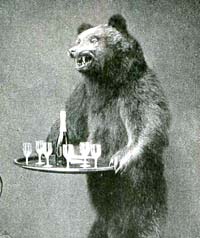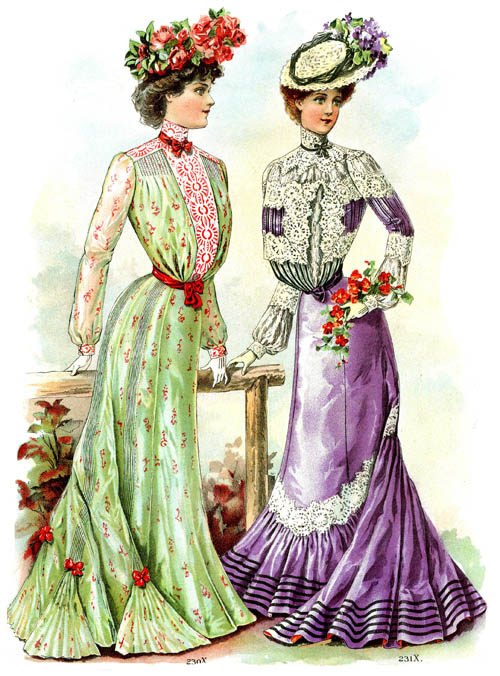|
Home > Objects, Curiosities & Antiquities > Victorian Curiosities

|
Anyone who supposes that the Victorian era was relentlessly staid, boring and hide-bound need only glance over the titles in this section to discover otherwise! Victorians loved eccentricities. The quest to find the biggest, rarest, and strangest was never-ending. One stimulus for this quest was the advent of photography; magazines like The Strand constantly sought new "wonders" to capture on film for their readers. But the Victorian love of oddities also manifests itself in some wonderful examples of imagination and fantasy - such as artists who painted elaborate pictures on fungi, or created full-scale pieces of furniture from matchboxes. Even more amazing is that many of these imaginative artists didn't think of themselves as "artists" at all, but just "ordinary folks"!
|
- Oddities: Beards
(Cassell's Family Paper, 1860)
- What Becomes of Lost Luggage, by C.E. Fryer (Cassell's Family Magazine, 1876)
- On the remarkable items left behind on cabs, trains, and stations - and how they are processed and stored.
- My Petrified Bird's-Nest
(St. Nicholas, 1889)
- The Evolution of the Cycle (The Strand, 1892B)
- "Let us... amuse ourselves by contemplating the various extinct species [of bicycle]--those developments which have somehow taken the wrong turning in the course of evolution, have then stopped, and, as rare fossils, are now only looked at as rarities and curiosities." Judging by the illustrations of these precursors of our bicycle, we should be grateful that they did, indeed, stop!
- The Biggest Tobacco-Box in the World, by Harry How
(The Strand, 1894B)
- Some Curiosities of Modern Photography, by William T. FitzGerald
(The Strand, 1895A)
- A number of curious photos, including several used in the solving of crimes.
- The Lost Property Office, by William G. FitzGerald
(The Strand, 1895B)
- The final destination of items lost or abandoned in cabs or trains - where officials have dealt with everything from skulls to sacks of gold to (living) babies!
- Some Remarkable Wedding Cakes, by Framley Steelcroft (The Strand, 1895B)
- The illustrations "take the cake" in this article on royal wedding cakes, including the one for Princess Louise, which weighed about 2000 pounds!
- Curiosities of Angling, by Framley Steelcroft (The Strand, 1896A)
- A look at some fishing trophies, fishing records, and peculiar objects made to celebrate the art of angling.
- "Animal" Furniture, by William G. FitzGerald
(The Strand, 1896B)
- Stuffed bears holding trays, a chair made from a giraffe, and other examples of the dark side of Victorian décor...
- Nose-Improvers, by L.S. Lewis
(The Strand, 1896B)
- Devices designed to clamp upon your nose to make it longer, shorter, straighter, or whatever you may desire. Perhaps this should not be tried at home.
- Beer-Markers, by George Dollar
(The Strand, 1897A)
- These are "little puppets of knitted wool, about 4 inches high," that are attached to the handles of beer steins so that when the stein is sent for a refill, it is returned to the proper owner.
- Distorting Mirrors, by L.S. Lewis
(The Strand, 1897B)
- The GPO [General Post Office] Museum, by Framley Steelcroft
(The Strand, 1897B)
- Curiosities of the Post and the history of the postal service.
- [Tattoos] Pictures on the Human Skin, by Gambier Bolton
(The Strand, 1897A)
- Skin Writing, by Jeremy Broome
(The Strand, 1897B)
- Literally a form of writing on the skin, with a blunt instrument, to create temporary marks and pictures.
- Peculiar Churches, by Louis Greville
(The Strand, 1897B)
- These include a church made of snow and sealskins, a church in a redwood tree, and a Ugandan cathedral.
- Some Peculiar Wills, by L.S. Lewis
(The Strand, 1897B)
- Not all of these involved paper!
- Things Made by Children, by Robert Henderson (The Strand, 1897B)
- "The writer of this article has made it his business to search the whole country through for interesting specimens of ingenious work done entirely by children." And he certainly found a number of them, from dollhouses to a prayer cut out of wood with a fret-saw!
- The Biggest Picture on Record
(The Strand, 1898A)
- A giant picture by the Japanese artist Hokusai.
- The Cunning of the Cutler: Queer Things Made in Sheffield
(Home Magazine, 1898)
- A knife worth nearly 1000 pounds; a knife with 1895 blades.
- Marvels in Match-boxes, by S.L. Neville-Dixon (The Strand, 1898A)
- A matchbox company ran a competition for designs created using just their matchboxes; here are some of the amazing results.
- Trade Trophies, by William G. FitzGerald
(The Strand, 1898A)
- Fantastic creations from soap, wax, butter, salt, and other substances.
- The Comical Cocoanut, by Thomas Curtis
(The Strand, 1898B)
- Curious cocoanut carvings.
- Curious Fences, by Thomas Curtis
(The Strand, 1898B)
- Curiosities of Church and Chapel
(Home Magazine, 1898)
- Oddities in church architecture and furnishings.
- Found in Uncle Sam's Mails, by Laura B. Starr (The Strand, 1898B)
- A look at oddities found in the museum of the Dead Letter Office, which has received such items as live rattlesnakes, skulls and other body parts, explosives, an alligator with a parasol, and even old boots.
- Picturesque People in Clay, Wood and Shell, by George Harper
(The Strand, 1898B)
- Postage Stamp Designs, by George Dollar
(The Strand, 1898A)
- Designs and works of art made from postage stamps.
- Royal Menus, by J.J. Moran (The Strand, 1898A)
- Some glimpses of how the royal family dined in the 1890's, including the wedding breakfasts of several of Queen Victoria's children, and a luncheon enjoyed by the German Emperor (the Queen's grandson) on his yacht during a race.
- Sponge Figures, by Albert Broadwell
(The Strand, 1898B)
- Biggest on Record, by George Dollar
(The Strand, 1899A)
- Everything from beards to toads...
- Decorated Bicycles, by Harold Shepstone (Windsor Magazine, 1899B)
- A look at some amazing competitions for decorated bicycles in England and Europe.
- Made of Money
(The Strand, 1899A)
- Objects made by a Civil War veteran of condemned American paper money pulp.
- Remarkable Cycles, by Harold J. Shepstone
(The Strand, 1899B)
- From the biggest cycle in the world to the youngest cyclist.
- Celebrities in Shells, by A.B. Maguire
(The Strand, 1900A)
- The shell figures of Mrs. Tatlow.
- Pictures on Fungi, by George Dollar
(The Strand, 1900A)
- New Hampshire artist Martha Cooper's amazing engravings on tree fungi.
- The Magic of Hairdressing, by Florence Burnley and Kathleen Schlesinger
(The Strand, 1900A)
- This is more about "bizarre oddities" of hairdressing than magic!
- The Queerest Bridges in the World, by Herbert Fyfe
(The Strand, 1900A)
- A Christmas Scene, by George Dollar
(Strand, 1900B)
- A remarkable Christmas diorama laid out every year by a resident of Washington, DC.
- Decorated Ostrich Eggs, by Laura Starr
(The Strand, 1900B)
- An Electric Man, by W.B. Northrop
(Strand, 1900B)
- An early automaton.
- An Extraordinary Suit
(Strand, 1900B)
- A suit crafted of bits of over 100 different animal and reptile skins.
- The Topsy-Turvey House at the Paris Exhibition, by Meta Henn
(The Strand, 1900B)
- As the title suggests, this is a full-size, upside-down house.
- The World's Cathedrals in Miniature, by Albert Broadwell
(The Strand, 1900B)
- A display of miniature cathedrals created by W. Gorringe.
- For Luck: A Curious Collection of Gamblers' Mascots, by Lewis Perry
(Strand, 1901B)
- Apparently many gamblers felt it was lucky to possess three ravens' eggs!
- Pulpit Devices, by E. Leslie Gilléains
(Strand, 1901B)
- A number of American gimmicks to entice people into church, and keep their attention once they were there. One of the most interesting is the "telephone church," which provided an early means of broadcasting the service to those who couldn't attend in person.
- A Wonderful Clock
(Strand, 1901B)
- Created by William Jankowsky, a Brooklyn carriage-builder, "Not only does this clock keep correct time, but it has several sets of chimes, electric lights, a phonograph, a music-box, a procession of ecclesiastical figures, a couple of miniature breech-loading cannon, a gas warming device, an electric fan, and an alarm."
|
Visit Our Victorian Shop
for:
Books
Coloring Books
Beautiful Spiral Journals
Holiday Greeting Cards
|
|


 Discover thousands of Victorian images in our
Discover thousands of Victorian images in our 